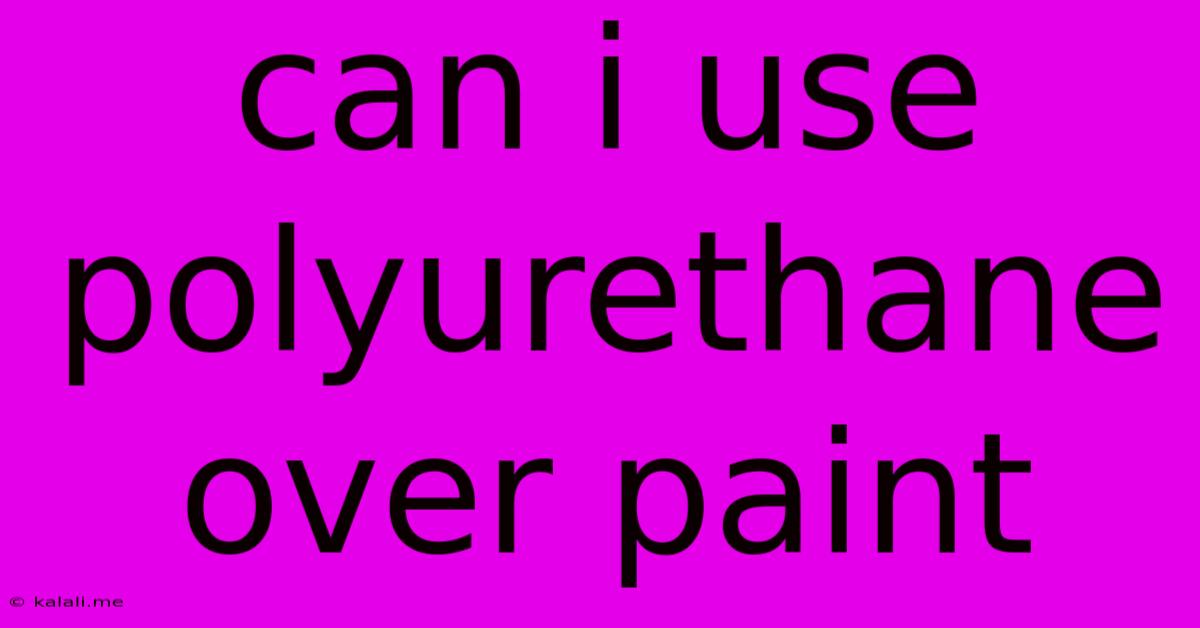Can I Use Polyurethane Over Paint
Kalali
Jun 10, 2025 · 4 min read

Table of Contents
Can I Use Polyurethane Over Paint? A Comprehensive Guide
Meta Description: Wondering if you can apply polyurethane over paint? This guide explores the pros, cons, and crucial steps to ensure a successful finish, covering various paint types and polyurethane options. Learn how to prepare your surface for optimal adhesion and achieve a durable, long-lasting result.
Applying polyurethane over paint is a common question among DIY enthusiasts and professional finishers alike. The answer, however, isn't a simple yes or no. The success of this process hinges on several factors, including the type of paint already on the surface, the type of polyurethane you choose, and proper surface preparation. This guide will explore these aspects in detail, empowering you to make an informed decision.
Understanding the Challenges: Why It's Not Always a Straightforward Process
Before diving into the possibilities, it's important to understand the potential hurdles. Polyurethane, a protective topcoat known for its durability and glossy finish, needs a compatible surface for proper adhesion. Applying it over unsuitable paint can lead to peeling, chipping, or a poor overall finish. Key considerations include:
- Paint Type: Oil-based paints typically provide a better base for polyurethane than water-based (latex) paints. Latex paints can sometimes have a slick surface that hinders adhesion.
- Paint Condition: The existing paint layer must be completely cured, smooth, and free from cracks, peeling, or other imperfections. Any flaws will likely show through the polyurethane.
- Polyurethane Type: Water-based and oil-based polyurethanes exist, and choosing the wrong type relative to the underlying paint can affect adhesion and the final look.
When Polyurethane Over Paint Can Work:
Despite the challenges, applying polyurethane over paint is feasible under the right conditions. Here are some scenarios where it's often successful:
- Oil-Based Paint Underneath: Oil-based paints generally offer excellent adhesion for both oil-based and water-based polyurethanes.
- Well-Prepared Surface: Thorough cleaning, sanding, and priming (if necessary) are paramount for successful adhesion. This prepares a receptive surface for the polyurethane.
- Proper Polyurethane Selection: Choosing a high-quality polyurethane formulated for the specific paint type minimizes the risk of incompatibility.
The Step-by-Step Guide: Achieving a Smooth, Durable Finish
If you decide to proceed, follow these steps meticulously:
-
Surface Preparation: This is the most critical step. Clean the surface thoroughly with a degreaser to remove dirt, grease, and dust. Lightly sand the existing paint to create a slightly rough surface that will improve adhesion. Remove all sanding dust with a tack cloth.
-
Priming (If Necessary): If you're applying polyurethane over a water-based paint or if the paint is particularly glossy, a primer is highly recommended. A high-quality bonding primer will create an even surface and improve adhesion.
-
Polyurethane Application: Apply thin, even coats of polyurethane, allowing sufficient drying time between each coat as specified by the manufacturer. Avoid heavy application to prevent runs and drips.
-
Drying Time: Allow ample drying time for each coat to cure completely before applying the next. This ensures a durable and long-lasting finish.
-
Finishing Touches (Optional): After the polyurethane has fully cured, you can lightly sand with very fine grit sandpaper to smooth out any imperfections, followed by another light application of polyurethane for an even smoother final coat.
Choosing the Right Polyurethane: Oil-Based vs. Water-Based
The choice between oil-based and water-based polyurethane depends largely on personal preference and the type of paint already present.
-
Oil-Based Polyurethane: Offers superior durability and a richer, glossier finish. It's generally more suitable for oil-based paints. However, it has stronger fumes and requires longer drying times.
-
Water-Based Polyurethane: Lower in VOCs (Volatile Organic Compounds), making it a more environmentally friendly option. It's easier to clean up and dries faster. It can be used over oil-based and some water-based paints but may not offer the same level of durability as oil-based polyurethane.
Conclusion: Informed Choice is Key
Applying polyurethane over paint is achievable with careful planning and execution. By understanding the challenges, preparing the surface properly, and selecting the right polyurethane type, you can achieve a beautiful and durable finish. Remember, proper surface preparation is the key to success! If you are unsure, it's always best to test a small, inconspicuous area first before proceeding with the entire project.
Latest Posts
Latest Posts
-
What Is The Radius Of The Moon
Jun 12, 2025
-
In The Passage The Author Is Primarily Concerned With
Jun 12, 2025
-
Moment Of Inertia Of Rectangular Plate
Jun 12, 2025
-
Acceptance Rate National University Of Singapore
Jun 12, 2025
-
University Of Hong Kong Acceptance Rate
Jun 12, 2025
Related Post
Thank you for visiting our website which covers about Can I Use Polyurethane Over Paint . We hope the information provided has been useful to you. Feel free to contact us if you have any questions or need further assistance. See you next time and don't miss to bookmark.